#sabelt seats
Explore tagged Tumblr posts
Text



FRESH IN: Back and in stock. The popular Sabelt GT3 (SABRFSEGT3N) FIA Motorsport bucket seats. Perfect for taller drivers looking for comfort and support. We've got a pair ready for in-store testing, same-day collection/dispatch is available! 🏁😁
SABELT GT3: https://www.sportseats4u.co.uk/product/sabelt-gt3-motorsport-seat/
#sabelt#sabelt gt3#sabelt seats#SABRFSEGT3N#sabelt racing#racing seats#bucket seats#sport seats#fia seats#gsmperformance#racingseats#sportseats#bucketseats
0 notes
Photo






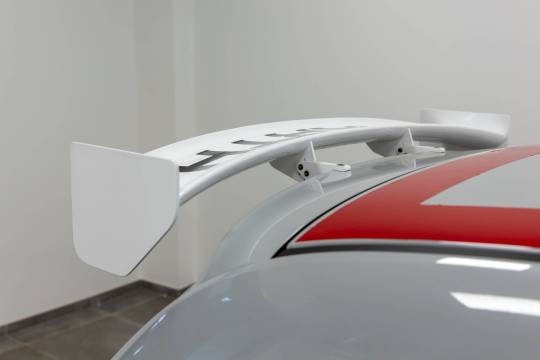


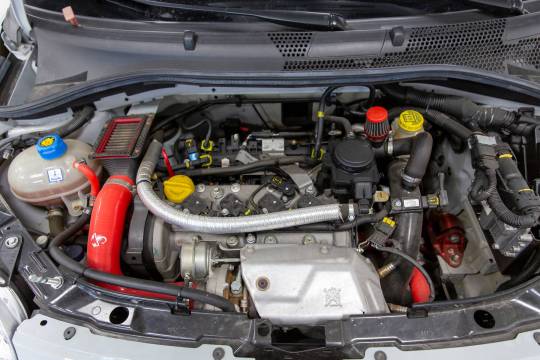
Abarth 500 Assetto Corse (1 of 49).
The brand Abarth came back on top of the scene with the model 500, genuine little sport car with its 1.4 Turbo engine of 135 horsepower, its bodybuilded front and rear faces and the numerous specific parts badged with the Scorpion. So to speak, there’s not a lot left from the Fiat 500 that is used as the base of the Abarth. The success was immediate and the brand launched an explosive track day car in 2009, a limited edition to 49 units. The 4-cylinder has been upgraded to 200 horsepower and 300 Nm at 3000 rpm, it is associated to a 6-manual gearbox to preserve the best racing feelings. The power is transferred to the wonderful 17” wheels via a mechanical limited slip differential and the Brembo disc brakes ensure the decelerations. As a real racing car this Abarth received a complete rollbar, a bucket seat with Sabelt harness, an extinguisher, carbon door panels and a competition steering wheel. To ensure the performances, the car has been lightened 180 kilos from the serial Abarth 500 so it weights only 930 kg! From the outside the body kit is impressive with many carbon elements, the massive spoiler and the historical racing red stripes. This configuration called Assetto Corse has been produced at only 49 units and is exclusively for track use.
102 notes
·
View notes
Text

2002 JGTC GT300 SERIES CHAMPION
ARTA A'PEX MR-S 2002 JGTC SERIES
GT300 class series victory
BASE VEHICLE
Toyota MR-S
Model ZZW30
Model year August 2000 (GT300 specification MR-S car No. 2)
ENGINE TYPE
3S-GTE
MAXIMUM POWER/MAXIMUM TORQUE
300ps or more 45kgm or more
TURBINE
A'PEX AX53B60 Racing Turbine
INTAKE AND EXHAUST SYSTEM
Cleaner A'PEX power intake
Muffler (HAYABUSA) Prototype
COOLING SYSTEM
A'PEX Prototype Intercooler
A'PEX GTspec, Radiator Prototype
TOYOTA TRD oil cooler
BRAKING SYSTEM
front rotor AP
rear rotor AP
front pad PFC
rear bud PFC
brake hose I-CORE
SUSPENSION SYSTEM
shock absorber
A'PEX N1 Damper Prototype
TIRES
BFGoodrich
WHEELS
RAYS TE37
POWER TRANSMISSION/TRAVEL DEVICE
tower bar
MISSION X-trac 6 speed sequential
DIFF TRD
CLUTCH ORC 5.5 inch tribble
ENGINE OIL
E880
INTERIOR
Steering wheel Sabelt
Seat Sabelt
Seatbelt TRD
5 notes
·
View notes
Text
Seat Belt Pads Sabelt
Equip your vehicle with the latest industry products! Buy Seat Belt Pads Sabelt SB450040/S Red Velcro (2 uds) and don’t miss out on anything! Colour: Red Type: Pad or pillow for belt Quantity: 2 uds Locks: Velcro

View On WordPress
0 notes
Text
Sabelt Puts Sustainability in Driver’s Seat
The flax fields of Belgium and France provide natural fiber reinforcement for seats in high-performance vehicles. from plasticstoday.com - Community for Plastics Professionals https://ift.tt/zVo0XHE
0 notes
Photo

6 notes
·
View notes
Photo

"Beeep boop beep beep boop beeeeeep" 💕 #starwars #legostarwars #lego #me #personal #finallymine #lunchbreak #seat #sabelt #working #friday #afternoon #freakyfriday #piedmont #piemonte (at Turin, Italy)
#starwars#piedmont#freakyfriday#legostarwars#me#lunchbreak#seat#personal#sabelt#afternoon#lego#finallymine#friday#working#piemonte
1 note
·
View note
Text

The Sabelt GT3 is perfect for the taller driver. We have pairs of these ready and available for immediate dispatch/collection. What project car would you fit them in? 🏁😁
0 notes
Photo
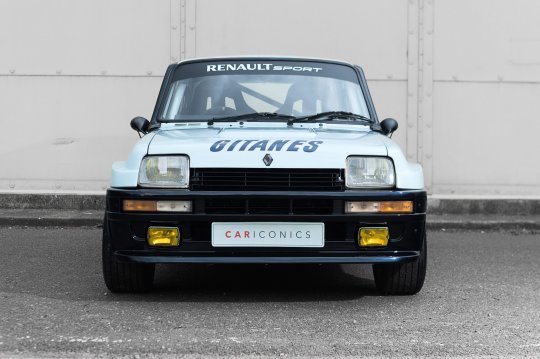




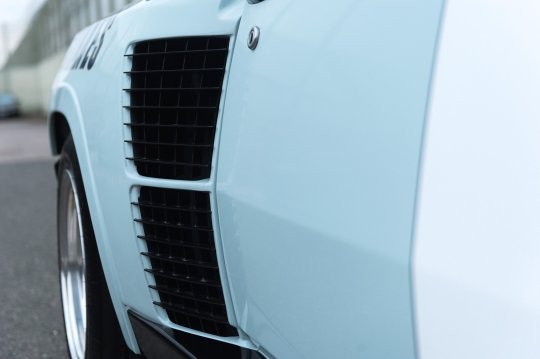

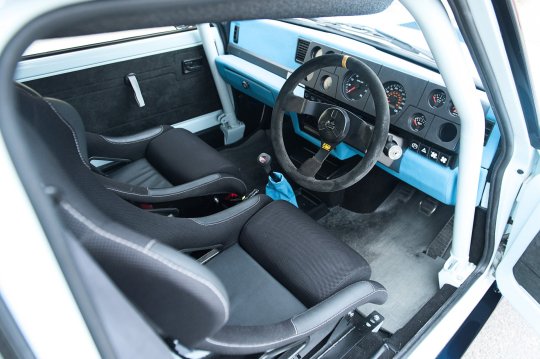


Renault 5 Turbo 2 Tour de Course Spec
The outlandish bodykit is no disguise. When Renault wanted to take its classic 5 hatchback rallying in the 1980s, they didn't just uprate the engine. They moved the highly modified power unit backwards to transform France's favourite supermarket shopper into a rallying two-seater supercar. Open the hatchback on this immaculate Renault 5 Turbo 2, resplendent in the 'Tour de Corse' colours that twice won one of the most demanding events on the rallying calendar, and there is the potent power unit, initially tuned using Renault's Formula The Renault began life as a production Turbo 2, a road-legal homologation special built in small numbers to meet Group B rallying regulations. Inside, there is a full competition interior, including a bespoke aluminium roll cage complemented by ultra lightweight Sparco seats and essentials such as a plumbed-in fire extinguisher. Door cards are carbon fibre to save weight. Full Sabelt harnesses are fitted. Bespoke switches are marked by crude, clear labelling. There's little in the way of creature comforts. In stark contrast to the specialist equipment, much of the standard Renault 5 dashboard remains, an analogue reminder of the original hatchback, albeit now punctuated with specialist gauges and switchgear.Every detail of this Tour de Corse recreation is correct, down to the finest points of the exterior livery. The condition is immaculate and the Renault is, remarkably enough, road legal. For your next rally stage or as a very swift supermarket shopper, there really is nothing like it. Just remember there’s no room for the week's groceries in the back.
67 notes
·
View notes
Photo

Ginetta G4 Race Car the right-hand-drive cockpit houses a single bolstered seat with a Sabelt five-point harness.
2 notes
·
View notes
Photo








First Look: The Alfa Romeo Giulia GTA
Alfa Romeo boasts a unique history and, on 24 June, it will have been in business for 110 years, during which its engineers and designers have relentlessly pursued innovation. Over the years, this combination has created some of the most iconic vehicles ever built, and to mark its 110th birthday, Alfa Romeo will pay tribute to one of its most emblematic vehicles: Giulia GTA.
Available in two versions, the Giulia GTA with four seats and the Giulia GTAm with two race seats, roll-bar and six-point harness, they will both feature the 2.9-litre V6 Bi-Turbo petrol engine producing 540hp along with a raft of weight saving solutions to remain true to the ethos of the original 1965 model.
Specific technical features and functional style On the Giulia GTA, the Alfa Romeo engineers have worked to improve the aerodynamics and handling but above all to reduce the weight. The active aerodynamics were specifically studied to increase the downforce. These solutions contain technical know-how that comes directly from Formula 1, thanks to the synergy with Sauber Engineering and the use of the Sauber Aerokit. The same task is assigned to the side skirts, the specific rear spoiler and the active front splitter.
The titanium Akrapovič central exhaust system, integrated in the carbon fiber rear diffuser, is also new, as are the 20-inch center lock wheels. Handling at high speeds has been improved by widening the front and rear wheel tracks by 50mm and developing a new set of springs, shock absorbers and bushings for the suspension systems.
On the GTAm, the aerodynamic front has been optimized by adding a larger front splitter and a real carbon-fiber rear wing, which ensure a perfectly balanced load at high speeds. In terms of performance, the Alfa Romeo 2.9-liter V6 Bi-Turbo engine, made entirely of aluminium and capable of unleashing no less than 510hp in the standard configuration, reaches an output of 540hp in the Giulia GTA thanks to the meticulous development and calibration work of the Alfa Romeo engineers. A new Akrapovič central exhaust system, in titanium and gives the car an unmistakable sound.
An Alcantara trimmed dashboard, door panels, glove compartment, side pillars and the central trim on the seats, characterize the interior. Alcantara® is used even more extensively in the GTAm version, where the rear bench has been removed, leaving room for a fully upholstered ‘basin’, with specific mouldings designed to hold helmets and a fire extinguisher. The new matte carbon-fiber inserts give the interior a distinctive technical and aesthetic elegance. In the new GTAm, the interior is unique in that it features a roll-bar, no door panels or rear seats and the door is opened with a belt in place of the handle, another touch inspired by the racing world.
An excellent power-to-weight ratio Power on its own is not enough to ensure extraordinary performance. The work done to reduce the vehicle weight has been meticulous, with the total weight reduction amounting to 100kg. To achieve this the GTA uses lightweight materials such as carbon fiber for the drive shaft, bonnet, roof, front bumper, front wheel arches and rear wheel arch inserts and the shell of the sports seats with six-point Sabelt seat belts in the GTAm. Aluminium has been used in the engine, doors and suspension systems and various other composite materials have been used throughout.
In the GTAm, Lexan – a unique polycarbonate resin which comes straight from the world of motorsport – has been used in the side and rear window frames, further contributing to the weight reduction. The result is a weight of around 1,520kg which, combined with the increase in output to 540hp, brings the power-to-weight ratio to 2.82 kg/hp, making the Giulia GTAm capable of delivering extraordinary performance. Its acceleration from zero to 62mph, with the Launch Control system, is just 3.6 seconds. The Giulia GTAm is a two-seater configuration that is road legal, with front splitter and larger visible rear wing in carbon.
In the GTA trim, with the same output, the Giulia offers four seats, no rear roll-bar, a spoiler and splitter optimized for daily use and the same door panels, seats and windows as those of the Giulia Quadrifoglio. The result is a veritable supercar for everyday use.
A privilege for 500 lucky customers The Alfa Romeo Giulia GTA and its extreme version, the Giulia GTAm, will be built in a limited edition of only 500 units in total, all numbered and certified and ready to take up their place alongside their 1965 forerunner as one of the most sought-after collector’s items. They are not only magnificent to look at, they are also ready to unleash their impressive power on the road, usable thanks to a series of sophisticated technical solutions.
An exclusive dedicated customer experience, designed to treat the 500 lucky owners to a unique experience that is 100% Alfa Romeo will come as standard. The owners will receive a personalized experience package, which includes a Bell helmet in special GTA livery, a full racing set by Alpinestars (race suit, gloves and shoes) and a personalized Goodwool car cover for protecting their GTA or GTAm. Customers can also take part in a specific driving course devised by the Alfa Romeo Driving Academy.
A set of initials with a legendary feel: GTA The acronym GTA stands for ‘Gran Turismo Alleggerita’ (alleggerita being the Italian term for “lightened”), and it originated in 1965 with the Giulia Sprint GTA, a specific version derived from the Sprint GT. The body of the Giulia Sprint GT was replaced with an identical version in aluminium, giving a total weight of 745kg compared to the 950kg of the road version.
A second variation concerned the 1,570cm3 twin-cam engine which, in the road configuration, reached an impressive output of 115hp and in the GTA it developed a maximum output of 170hp thanks to the Autodelta technicians from the Alfa Romeo race team. The model’s success in competitions was then immediate: three consecutive ‘Challenge Europeo Marche’, tens of national championships and hundreds of individual races in every part of the world. The Giulia Sprint GTA expressed the claim “A victory a day in your everyday car” to perfection. From then on, the GTA made a name for itself as the undisputed icon of Alfa Romeo sportiness.
#Giulia GTA#Alfa Romeo Giulia GTA#Alfa Romeo#Cars#news#Giulia#Geneva Motor Show#italian#italy#Giulia GTAm#supercars
92 notes
·
View notes
Photo





First Look: The Ferrari 488 GT3 Evo 2020
The new version of the 488 GT3, which will compete in the main international GT championships in 2020, has just been unveiled at the Ferrari Finali Mondiali at Mugello. The new Evo package is the result of Ferrari’s desire to further refine certain aspects of one of the most successful cars in the marque’s history. This has been achieved using innovative concepts derived from its track experience and feedback from the teams competing with the 488 GT3.
Aerodynamics, vehicle dynamics, ergonomics, safety and reliability were the main focuses of development, all, of course, in compliance with the strict power and aerodynamic efficiency performance limits imposed by FIA regulations.
The engineers honed the 488 GT3 Evo 2020's aerodynamics to boost the car's stability with the new front-end design making a significant contribution. Over 18,000 hours of calculations and CFD simulations, followed by wind tunnel testing, went into the design of a new bumper with a smaller frontal section under the headlights. This has allowed the introduction of a pair of flicks to generate more downforce, making the car more stable without modifying the aero balance thanks in part to turning vanes inside the splitter. Aerodynamic development also extended to other areas of the front of the 488 GT3: the vents on top the wings are larger than the current model and the front section of the door is now more tapered to more efficiently channel lateral flows. The vents on the rear wing have also been completely redesigned.
The 488 GT3’s vehicle dynamics have been key in its success, and this area has been further improved in the new 488 GT3 Evo 2020. The wheelbase is longer, as in the 488 GTE, to optimize tire use, reduce tire wear and facilitate the conversion from GT3 to GTE. The engineers also focused on reducing the car's weight with the result that more ballast can be used to attain the minimum weight imposed by the Balance of Performance, thus lowering the center of gravity. In addition all the vehicle dynamic controls, including the traction control and ABS, have been optimized.
No performance upgrades have been made to the engine, a twin-turbo V8 with a 90-degree angle between the cylinder banks, nor have any components been modified. However, it does benefit from a new engine management system which improves reliability and guarantees smoother, more precise torque delivery.
Endurance racing has evolved to the extent that it is increasingly resembling extended sprint racing. This demands meticulous attention to detail, including in the cockpit. The 488 GT3 Evo 2020 debuts a new seat which meets the new FIA safety regulations. Developed jointly with Sabelt for both the GT3 and GTE, it is not only more rigid and robust but is also 2.4 kg lighter with new belts and a new buckle.
The additional 24H/Endurance package is specifically designed for clients interested in that particular type of racing. The basic equipment includes a front bumper with additional headlights, quick-fill couplings for engine oil and coolant, carbon-fiber clutch, brake calipers adopted from the GTE and steel wheel nuts. Optional features include sensors for the coolant level and refuelling completion with warning lights, and Le Mans-type, 4,500 lumen LED main headlights.
The new components and improvements introduced in the 2020 version of the 488 GT3 Evo are also available as upgrade kits for existing cars.
#Ferrari 488 GT3 Evo#Ferrari 488 GT3#488 GT3 Evo#cars#ferrari#racing#gt3#Ferrari 488#wec#scuderia ferrari#supercar#race cars
27 notes
·
View notes
Video
youtube
Alfa Romeo 156 Twin Spark 2.0 L 16 valves - Group N
Engine Alfa Romeo Twin Spark 2.0L 16 valve Gearbox 5-speed H Adjustable suspension (track or rally). Brembo Racing braking system with ventilated discs. Self-locking differential. Sabelt Racing interior set-up; Seats and belts expiring in 2025. Carbon interior panels. Prepared for Rally, HillClimb and Track: Group N, Class 2000 Documents: Spanish plates and documents; Technical passport; Homologation forms
http://www.moreschi.info/auto.htm
3 notes
·
View notes
Photo
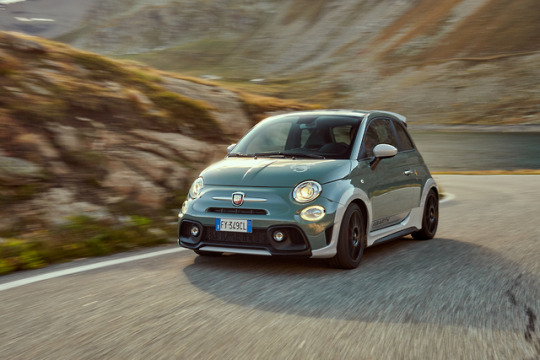
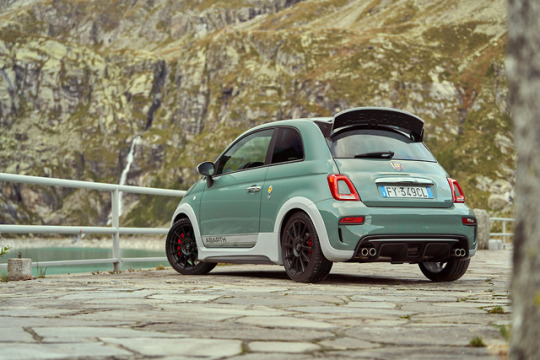
The new Abarth 695 70th Anniversario special edition was launched today in Milan to celebrate 70 years since Abarth & C. was founded by Carlo Abarth (1908 - 1979). Only 1,949 units are being produced.
The new Abarth 695 70th Anniversario is equipped with the new “Spoiler ad Assetto Variabile” to deliver improved grip and stability at high speeds and increases overall performance. The spoiler is manually adjustable - it can be adjusted in 12 different positions between zero and 60 degrees.
The 17-inch SuperSport alloy wheels and red Brembo brake calipers are also standard. The Brembo brakes are fitted with four-piston aluminium calipers and 305mm discs at the front and 240mm discs at the rear, both self-ventilated. The Record Monza exhaust, limited slip differential and Xenon headlights all feature as standard.
Five exterior colours are available, including the exclusive new Monza 1958 green, Circuit Grey, Gara White, Scorpione Black and Podium Blue. The glorious racing past of the brand is also referenced by the badges on the body in heritage font, featuring the vintage Scorpion emblem.
Inside, the Abarth 695 70th Anniversario features exclusive "Sabelt Tricolore" seats, developed specifically for this special edition. Each of the 1,949 units will have a numbered plaque, making the 695 70th Anniversario an authentic collectable.
The new 695 70th Anniversario is equipped with the 1.4-litre turbocharged petrol engine which delivers 180hp and 250Nm of torque at 3,000rpm, with a top speed of 139mph (with spoiler set to zero degree position) while accelerating from zero to 62mph in just 6.7 seconds.
21 notes
·
View notes
Photo










1979 Porsche 935 Replica (Birmingham, AL) $279,900
This is truly something special, this started it's life as a 1979 930. The body work is full 935 Kremer K3 Bodywork by American International Racing, Burbank CA. Includes one piece front with removable rear quarters. Adjustable Rear Wing and Front Lip. Powered by a 3.3L Twin Turbo Engine that is very close to 935 specs with sealed Twin plug Heads, Cams, Carillo Rods and Balanced Pistons & Cylinders. The Engine is approximately 20 hours fresh with a Full cage by Fabcar. Additional features include but are not limited to a Sabelt 6 point harness Recaro Prof. Racing seat. Case is shuffle pinned and bow-tailed, Fabcar designed the intercooler & induction systems! Gear box built using 935 gears sets & forks, 935 metal disc 934 pressure plate. Present gearing at 7400RPM in 4th reaches mid 180MPH range. Custom exhaust system by Franz Blam Racing in Tucker, GA. Includes 2 Sets of BBS Racing Modular Wheels 11X16 front 15X16 rear. Front & Rear suspension pick up points modified to 935 specs. Coil overs Front & Rear, 935 Bilstein Shocks and Springs, 92854 brakes Group C high efficiency Oil cooler, Indy car style Oil tank. 15gal ATS fuel cell, w/Internal Surge tank (2014 bladder) On board fire system & Fuel pump shut off and external Kill Switch, Full 935 instrumentation including Fuel pressure & Intercooler air temperature gauges. Owned by long time Porsche Club Member. This Porsche is very dependable with many HSR victories under Angelo Cille and is currently eligible for Historic Races. Please check out www.steelcityclassics.com for some of the nicest classics in the south.
For more information or to schedule a viewing give our friend Lee a call at 205-492-0870
#classic car for sale#classic cars for sale#classic car for sales#classic cars for sales#classic car#classic cars#muscle car#muscle cars#muscle car for sale#car for sale#car for sales#cars for sale#cars for sales#mixed race#race chaser#race car#race car for sale#race cars for sales#car#cars
3 notes
·
View notes
Photo

For sale SABELT GT200 race seat size ML only used for mock up FIA good until 2018, with rails $600 boo located in so cal #race #racecar #seat #sabelt #recaro #raceseat #nasa #forsale #scca #autocross #roadracing (at Hawthorne, California)
6 notes
·
View notes